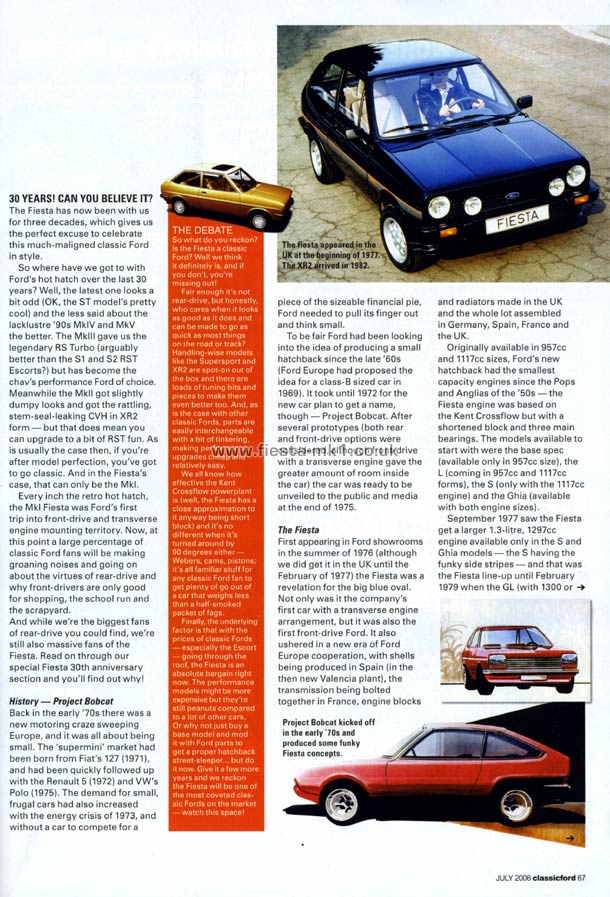Copy of Article Text Below
30 Years! Can you believe it? The Fiesta has now been with us for three decades, which gives us the perfect excuse to celebrate this much-maligned classic Ford in style.
So where have we got to with Ford's hot hatch over the last 30 years? Well, the latest one looks a bit odd (OK, the ST model's pretty cool) and the less said about the lacklustre '90s MklV and MkV the better. The Mklll gave us the legendary RS Turbo (arguably better than the S1 and S2 RST Escorts?) but has become the chav's performance Ford of choice. Meanwhile the Mkll got slightly dumpy looks and got the rattling, stem-seal-leaking CVH in XR2 form - but that does mean you can upgrade to a bit of RST fun. As is usually the case then, if you're after model perfection, you've got to go classic. And in the Fiesta's case, that can only be the Mkl.
Every inch the retro hot hatch, the Mkl Fiesta was Ford's first trip into front-drive and transverse engine mounting territory. Now, at this point a large percentage of classic Ford fans will be making groaning noises and going on about the virtues of rear-drive and why front-drivers are only good for shopping, the school run and the scrapyard.
And while we're the biggest fans of rear-drive you could find, we're still also massive fans of the Fiesta. Read on through our special Fiesta 30th anniversary section and you'll find out why!
History - Project Bobcat
Back in the early '70s there was a new motoring craze sweeping Europe, and it was all about being small. The 'supermini' market had been born from Fiat's 127 (1971), and had been quickly followed up with the Renault 5 (1972) and VW's Polo (1975). The demand for small, frugal cars had also increased with the energy crisis of 1973, and without a car to compete for a piece of the sizeable financial pie, Ford needed to pull its finger out and think small.
To be fair Ford had been looking into the idea of producing a small hatchback since the late '60s (Ford Europe had proposed the idea for a class-B sized car in 1969). It took until 1972 for the new car plan to get a name, though - Project Bobcat. After several prototypes (both rear and front-drive options were considered, although front-drive with a transverse engine gave the greater amount of room inside the car) the car was ready to be unveiled to the public and media at the end of 1975.
The Fiesta
First appearing in Ford showrooms in the summer of 1976 (although we did get it in the UK until the February of 1977) the Fiesta was a revelation for the big blue oval. Not only was it the company's first car with a transverse engine arrangement, but it was also the first front-drive Ford. It also ushered in a new era of Ford Europe cooperation, with shells being produced in Spain (in the then new Valencia plant), the transmission being bolted together in France, engine blocks and radiators made in the UK and the whole lot assembled in Germany, Spain, France and the UK.
Originally available in 957cc and 1117cc sizes, Ford's new hatchback had the smallest capacity engines since the Pops and Anglias of the '50s - the Fiesta engine was based on the Kent Crossflow but with a shortened block and three main bearings. The models available to start with were the base spec (available only in 957cc size), the L (coming in 957cc and 1117cc forms), the S (only with the 1117cc engine) and the Ghia (available with both engine sizes).
September 1977 saw the Fiesta get a larger 1.3-litre, 1297cc engine available only in the S and Ghia models - the S having the funky side stripes - and that was the Fiesta line-up until February 1979 when the GL (with 1300 or.....
THE DEBATE
So what do you reckon? Is the Fiesta a classic Ford? Well we think it definitely is, and if you don't, you're missing out!
Fair enough it's not rear-drive, but honestly, who cares when it looks as good as it does and can be made to go as quick as most things on the road or track? Handling-wise models like the Supersport and XR2 are spot-on out of the box and there are loads of tuning bits and pieces to make them even better too. And, as is the case with other classic Fords, parts are easily interchangeable with a bit of tinkering, making performance upgrades cheap and relatively easy.
We all know how effective the Kent Crossflow powerplant is (well, the Fiesta has a close approximation to it anyway being short block) and it's no different when it's turned around by 90 degrees either - Webers, cams, pistons; it's all familiar stuff for any classic Ford fan to get plenty of go out of a car that weighs less than a half-smoked packet of fags.
Finally, the underlying factor is that with the prices of classic Fords - especially the Escort - going through the roof, the Fiesta is an absolute bargain right now. The performance models might be more expensive but they're still peanuts compared to a lot of other cars. Or why not just buy a base model and mod it with Ford parts to get a proper hatchback street-sleeper... but do it now. Give it a few more years and we reckon the Fiesta will be one of the most coveted classic Fords on the market - watch this space!
Captions -
Top-Right - The Fiesta appeared in the UK at the beginning of 1977. The XR2 arrived in 1982.
Bottom-Right - Project Bobcat kicked off in the early'70s and produced some funky Fiesta concepts.
|




